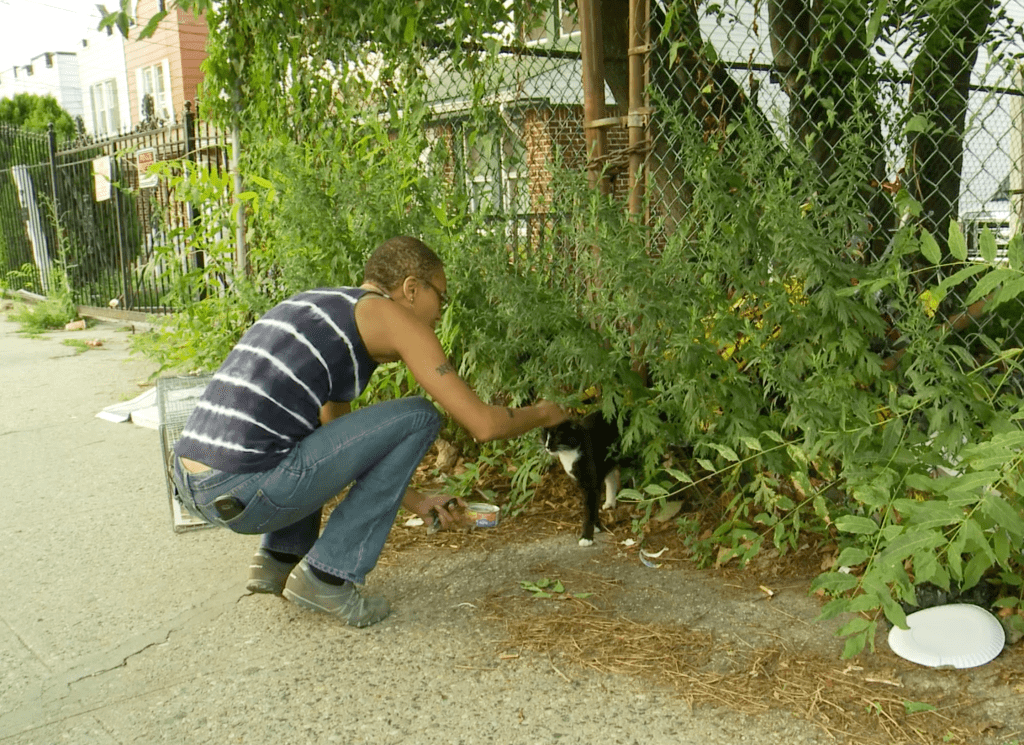
As an opening title card in the new documentary, The Cat Rescuers, explains, there are roughly 500,000 stray cats living in New York City. While local organizations like the ASCPA and the privately-owned, Animal Care and Control of NYC, do what they can to control that population, there simply aren’t enough resources to deal with a problem so large. Enter the titular group of cat-loving private citizens who spend their own time and money caring for cats throughout Brooklyn. Directed by Rob Fruchtman and Steven Lawrence and financed through a 2017 Kickstarter campaign, The Cat Rescuers succeeds thanks not to the admittedly adorable series of felines the audience meet throughout, but because of how compelling its human subjects are.
We first meet, Latonya “Sassee” Walker, a self-proclaimed “Catwoman” who traps cats in an unexpectedly cartoonish way: by setting food under a box propped up by a stick, ready to pull the string attached to the stick as soon as the cats are underneath. Silly as the image is, the method is shockingly common, used by both Sassee and fellow rescuers, Claire Corey, Stuart Siet and Tara Green. Lest the audience mistake the film’s subjects for nefarious cat nappers, Fruchtman and Lawrence soon show a trapping class at a local ASPCA that explains the method is part of a humane policy called, “Trap, Neuter, Release” (TNR), that’s meant to stem stray cat population growth. There and throughout, it’s impressive to watch how much information Fruchtman and Lawrence embed between trapping scenes.
Still, though it is endless fun to watch the various rescuers use the ol’ box and stick trap, as the film goes on, it’s the more extreme measures the rescuers take that are most intriguing. To start, there’s the financial commitment. As Sassee notes, she spends at least $300 in cat food each month and one can only imagine how much Tara must spend bringing various cats to the vet nearly every day. However, while the financial toll is staggering to imagine, it’s the time commitment that seems most remarkable. Take the scene where, prompted by a call from her mother, Sassee waits five hours by a trap trying to capture a single, serially pregnant cat only to go home empty handed. A title card at the end of the scene notes she catches the cat a year later and it’s easy to imagine how many fruitless hours-long waits that must have entailed.
Indeed, the more the audience sees how far the rescuers are willing to go to take care of these cats, the more it begs the question: why? For much of the film, Fruchtman and Lawrence leave it unaddressed and as the film nears its end, it seems as if they never will. So, it’s surprising then when Tara reveals how she got her first cats as the filmmakers walk with her down the shore near her home in Gerritsen Beach. In a jarringly matter-of-fact tone, she explains that, after a woman she was seeing upstate was murdered by her boyfriend, her drug addiction became more serious until a friend forced her to take two cats, Wishbone and Burley, to cope. “I never grieved, “ she says, “I never learned how to grieve.” She goes on to explain that after that experience, she stayed both sober and single, channeling that commitment (and addiction as her mother, Anne says) into rescuing cats.
While the moment gives the psychological element the the audience has wanted from the beginning, some viewers will ultimately wish Fruchtman and Lawrence were more willing to dig in earlier and deeper. However, that’s not really their point. Rather, they only explore their subjects as a means of promoting what cat-loving viewers can do to stem the feral cat problems in their own cities. And while that choice may ultimately leave the film feeling a tad preachy, it’s hard to blame the directors for being a little like their human subjects. After all, it’s hard to watch The Cat Rescuers without feeling a little inspired by all that altruism.

